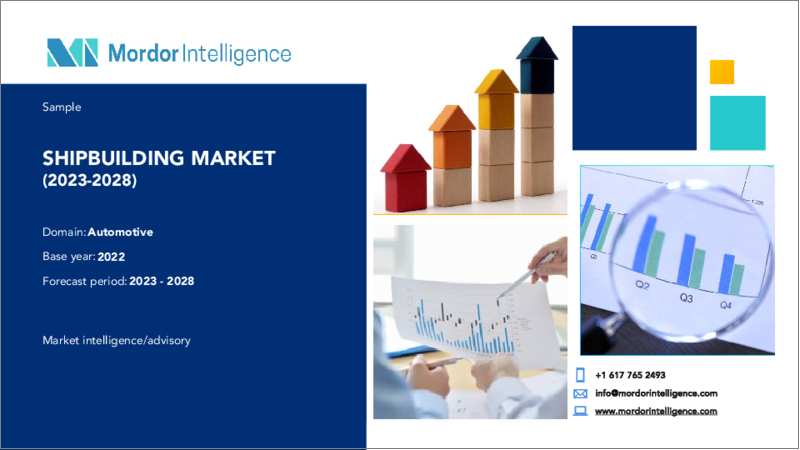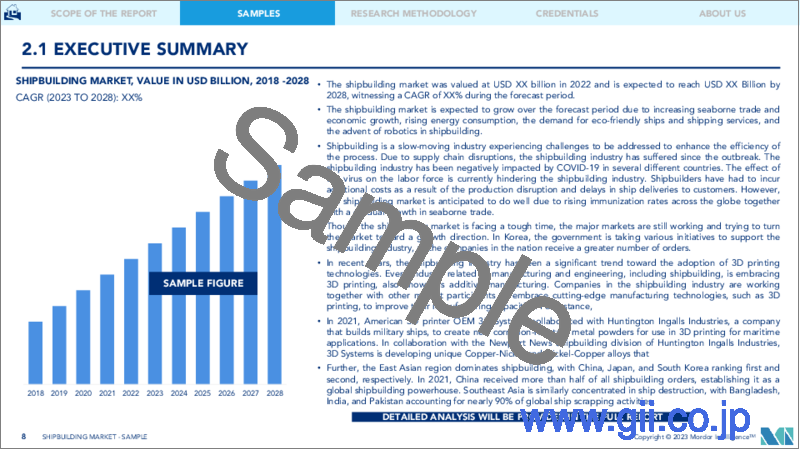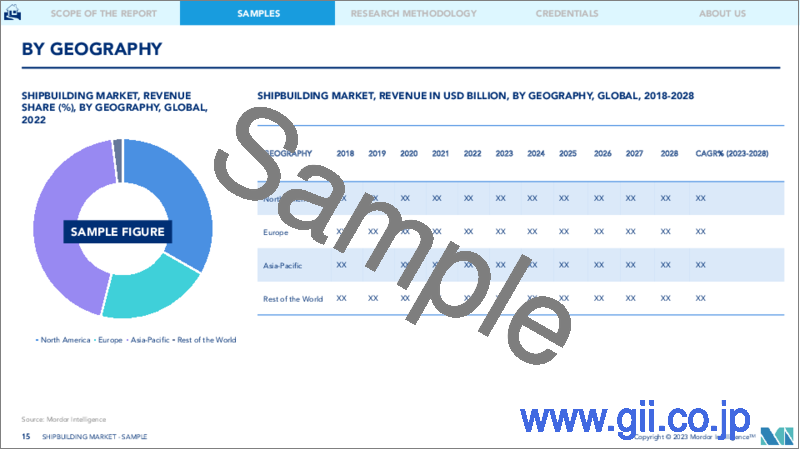|
|
市場調査レポート
商品コード
1198318
造船市場- 成長、動向、予測(2023年~2028年)Shipbuilding Market - Growth, Trends, and Forecasts (2023 - 2028) |
||||||
|
● お客様のご希望に応じて、既存データの加工や未掲載情報(例:国別セグメント)の追加などの対応が可能です。 詳細はお問い合わせください。 |
|||||||
| 造船市場- 成長、動向、予測(2023年~2028年) |
|
出版日: 2023年01月23日
発行: Mordor Intelligence
ページ情報: 英文 107 Pages
納期: 2~3営業日
|
- 全表示
- 概要
- 目次
造船市場は、2021年に1325億2000万米ドルとなり、予測期間(2022年~2027年)にはCAGR4.84%で推移する見通しで、2027年には1759億8000万米ドルに達すると予想されています。
COVID-19の発生は、数カ国の造船業に影響を与えました。このパンデミックの悪影響は、世界の船舶のサプライチェーンに顕著に現れました。船舶の建造に必要な期間が延長されたため、造船会社は遅延の結果、より多くのコストを負担することが予想されます。その結果、パンデミックによる生産中断による生産率の低下が、予測期間の最初の数年間は市場成長の妨げとなる可能性があります。
造船市場は、海上貿易の拡大と経済成長、エネルギー消費の増加、環境に優しい船舶と海運サービスの需要、造船におけるロボットの登場などにより、予測期間中に成長すると予想されます。
造船は、プロセスの効率を高めるために対処すべき課題を経験している動きの遅い産業であり、経済や環境の変化、進行中のCOVID-19パンデミック危機により、市場の成長をさらに押し下げています。
造船市場は厳しい状況にありますが、主要なプレーヤーは市場を成長方向に向かわせるために努力を続けています。韓国では、政府が造船業を支援するためにさまざまな取り組みを行っており、国内の企業がより多くの受注を獲得しています。
造船市場の動向
国家間の貿易活動の活発化が成長の原動力
世界の貿易量の5分の4以上が海路で行われており、海運は世界化した貿易と製造業のサプライチェーンを支えています。貿易量は増加しており、過去10年間の成長率はほぼ10%でした。輸入量の増加が比較的大きいのは、新興国の消費者需要の増加によって説明することができます。
海上輸送の需要が年々増加し、それに伴って世界全体で輸出入の件数が増えているのです。グローバリゼーションが多くの経済の根幹をなす中、国際的な商品取引の可能性が広がり、様々な価格帯の商品が入手しやすくなっています。例えば。
- EUは世界の貿易額の約15%を占め、輸入トン数は2020年まで5%ずつ着実に増加しています。今日、EUは毎年平均211のユニークな非EUの貿易相手国から輸入しており、これは商品の価値の22%増に相当し、2270億米ドルの商品を推定しています。海運は依然としてサプライヤーからバイヤーへの最も費用対効果の高い輸送手段であり、75%の商品が外部パートナーから海路で欧州に入ってきています。
トレードレーンに対する需要はCOVID-19のピーク時から着実に向上しており、これが複数の港湾運営会社を拡張へと向かわせています。例えば、次のようなことです。
- 2021年11月、ダブリン港湾会社(DPC)は、ダブリンの中心部にあるアイルランド最大の港を4億ユーロで拡張する長期計画を発表しました。広大な新貨物ターミナルの建設を軸に、2040年までに同港に必要と予想される容量の20%を実現する計画です。
- 2021年7月、中国政府は上海港拡張計画を発表しました。この計画では、地域港湾の拡大と港湾技術の強化に重点を置いています。この計画では、今後5年間で上海港のTEU取扱量の全体成長率8%の達成を目指しています。中国は、2025年までに上海が年間4700万TEUの取扱量を達成するとの見通しを示しています。
- 2021年4月には、南アフリカがダーバン港の近代化を目的とした70億米ドルの野心的な計画を発表し、効率化を目指しています。
こうした事例が造船業の成長を後押ししています。
アジア太平洋地域が市場を独占すると予想される
世界化に伴う輸出入商品の需要増により、造船業は重要な戦略産業となっています。欧州は依然として客船製造の重要な市場ですが、東アジア地域は中国、日本、韓国を中心とする造船大国であり、世界の造船市場の上位を占めています。中国は2021年の造船受注量の半分以上を獲得し、世界の造船大国としての地位を確立しています。船舶の破壊も同様に東南アジアに集中しており、バングラデシュ、インド、パキスタンが世界の船舶スクラップ活動の90%近くを占めています。
クラークソンズが発表したデータによると、2021年、中国は補償総トン数(CGT)別の年間受注量で韓国を抜いた。年間を通じて、中国の造船会社は合計2280万CGT以上の受注を獲得し、世界の合計4570万CGTのほぼ半分を占めました。韓国の造船会社は1750万CGTを受注し、全体の約38%を占めました。消費財の輸送量の増加により爆発的に伸びている新造コンテナ船の購入は、中国が独占しています。
アジア太平洋地域のもう一つの重要なプレーヤーは韓国です。2021年、韓国のビッグ3造船所は、利益率の高い高価値のLNG船に注力しました。韓国の造船所はLNG船市場をリードしており、カタール・エナジーのメガオーダー16隻、ペトロナス向け15隻を含む37隻の契約を獲得しています。KBSワールドによると、2021年に韓国の受注量が減少したのは、韓国の造船所が総量よりも高付加価値プロジェクトを優先し、選択性を高めたためです。
COVID-19が米国、欧州、アジアの経済圏に急速に広がったため、これ以上の拡大を防ぐために国単位でロックダウンや産業施設の一時停止が行われました。さらに、COVID-19の大流行により、造船所では新造船、整備、改造などのプロジェクトに遅れが生じています。パンデミックの結果、一部の企業は多くの国で造船所活動の停止を余儀なくされています。
造船市場の競合他社分析
造船市場は断片的であり、いくつかの企業が市場でかなりのシェアを占めています。著名な企業としては、三菱重工業、現代重工業、中国船舶工業集団公司、DSME、その他があります。企業は、新製品や高機能製品の革新のために、研究開発に多額の投資を行っています。例えば、以下のようなものです。
- 2021年9月、現代重は、環境に優しい船舶やデジタル船舶技術、スマート造船所、水素インフラなど、将来の技術への投資に約7,600億ウォン(6.6億米ドル)を使用する計画を明らかにしました。
その他の特典です。
- エクセル形式の市場予測(ME)シート
- アナリストによる3ヶ月間のサポート
目次
第1章 イントロダクション
- 調査の前提条件
- 調査範囲
第2章 調査手法
第3章 エグゼクティブサマリー
第4章 市場力学
- 市場促進要因
- 市場抑制要因
- 産業の魅力- ポーターのファイブフォース分析
- 新規参入業者の脅威
- 買い手/消費者の交渉力
- 供給企業の交渉力
- 代替品の脅威
- 競争企業間の敵対関係
第5章 市場セグメンテーション
- 船種
- 船舶
- コンテナ
- 旅客船
- その他のタイプ
- エンドユーザー
- 運送会社
- 軍関係者
- その他のエンドユーザー
- 地域
- 北米
- 米国
- カナダ
- その他北米地域
- 欧州
- ドイツ
- 英国
- フランス
- その他の欧州地域
- アジア太平洋地域
- 中国
- インド
- 日本
- 韓国
- その他アジア太平洋地域
- 世界のその他の地域
- ブラジル
- メキシコ
- アラブ首長国連邦
- その他の国
- 北米
第6章 競合情勢
- ベンダーの市場シェア
- 企業プロファイル
- Mitsubishi Heavy Industries Ltd
- Hyundai Heavy Industries Co. Ltd
- China State Shipbuilding Corporation
- Daewoo Shipbuilding Marine Engineering Co. Ltd
- Samsung Heavy Industries
- Sumitomo Heavy Industries
- Hanjin Heavy Industries and Construction Co.
- Yangzijiang Shipbuilding Ltd
- United Shipbuilding Corporation
- STX Group
第7章 市場機会と今後の動向
The shipbuilding market*was valued at USD 132.52 billion in 2021, and it is anticipated to reach USD 175.98 billion by 2027, at a CAGR of 4.84% during the forecast period (2022- 2027).
The COVID-19 outbreak has impacted the shipbuilding industry in several countries. The pandemic's negative effects were evident in worldwide ship supply chains. Given the extended durations necessary to construct ships, shipbuilders are expected to incur more costs as a result of the delays. As a result, the drop in production rates caused by pandemic-induced interruptions is likely to hinder the market growth during the first few years of the forecast period.
The shipbuilding market is expected to grow over the forecast period due to increasing seaborne trade and economic growth, rising energy consumption, the demand for eco-friendly ships and shipping services, and the advent of robotics in shipbuilding.
Shipbuilding is a slow-moving industry experiencing challenges to be addressed to enhance the efficiency of the process, which is further pushing back the market growth due to economic and environmental changes and the ongoing COVID-19 pandemic crisis.
Though the shipbuilding market is facing a tough time, the major players are still working and trying to turn the market toward a growth direction. In Korea, the government is taking various initiatives to support the shipbuilding industry, as the companies in the nation receive a greater number of orders.
Shipbuilding Market Trends
Increasing Trade Activities Between Countries is a Growth Driver
Marine transport is the backbone of globalized trade and the manufacturing supply chain, as more than four-fifths of the world's merchandise trade by volume is carried out through the marine route. The trade volume has increased, with a growth rate of almost 10% during the last decade. The relatively larger increase in the volume of imports can be explained by the increase in consumer demand in developing countries.
There has been an increase in demand for maritime transport over the years, which has caused a subsequent rise in the number of imports and exports across the world. With globalization taking root in the heart of many economies, there are growing possibilities for internationally trading goods providing a superior range of available products at different price points. For instance:
- The EU accounts for around 15% of the world's trade in goods, and import tonnage had steadily increased by 5% until 2020. Today, the European Union is importing from an average of 211 unique Non-EU trade partners each year, which represents a 22% increase in the value of goods, estimating USD 227 billion in goods. Shipping remains the most cost-effective means of transporting goods from supplier to buyer, with 75% of goods coming into Europe by sea from external partners.
The demand for the trade lane has been improving steadily since the peak of COVID-19, which is pushing several port operators for expansion. For instance:
- In November 2021, Dublin Port Company (DPC) unveiled its long-term plan for a EUR 400 million expansion of Ireland's biggest port in the heart of Dublin. Anchored by the construction of a vast new freight terminal, the plan is intended to deliver 20% of the capacity the port is expected to need by 2040.
- In July 2021, the Chinese government announced the Shanghai port expansion plan, which focuses on the enlargement of regional port operation and enhancement of the technology at the port. This plan aims at achieving 8% overall growth in TEU volumes at Shanghai Port over the next five-year period. China has forecasted that by 2025, Shanghai will be achieving the landmark of handling 47 million TEUs annually.
- In April 2021, South Africa unveiled an ambitious USD 7 billion plan to modernize the Port of Durban, aiming to improve its efficiency.
Such instances are aiding the growth of the shipbuilding industry.
Asia-Pacific is Expected to Dominate the Market
Due to the sheer increased requirement for import and export commodities, as a result of globalization, shipbuilding has become an essential strategic industry. Although Europe remains an important market for cruise ship manufacture, the East Asian area dominates shipbuilding, with China, Japan, and South Korea being the world's top shipbuilding nations. China obtained over half of all shipbuilding orders in 2021, establishing it as a worldwide shipbuilding powerhouse. Ship destruction is similarly concentrated in Southeast Asia, with Bangladesh, India, and Pakistan accounting for almost 90% of worldwide ship scrapping activities.
According to the data issued by Clarksons, in 2021, China surpassed South Korea in terms of yearly order volume by compensated gross ton (CGT). Over the course of the year, Chinese shipbuilders received orders totaling over 22.8 million CGT, accounting for nearly half of the global total of 45.7 million. South Korean builders received orders totaling 17.5 million CGT or around 38% of the total. China dominated purchases of new container ships, a market that has exploded due to an increase in consumer goods traffic.
Another important player in the Asia-Pacific region is South Korea. In 2021, the Big Three shipbuilders in South Korea focused on high-margin, high-value LNG carriers, which are more profitable. Korean shipyards lead the LNG carrier market, with 37 contracts, including 16 for Qatar Energy's mega-order and another 15 for Petronas. According to KBS World, Korean order volumes were lower in 2021 because South Korean shipbuilders were more selective, preferring high-value-added projects over total volume.
The rapid spread of COVID-19 throughout the economy of the United States, Europe, and Asia led to country-wide lockdowns and a temporary suspension of industrial facilities to prevent further spread. Furthermore, the COVID-19 pandemic has caused delays in shipyard projects such as new construction, maintenance, and conversion. As a result of the pandemic, certain firms have been compelled to halt their shipyard activities in a number of nations.
Shipbuilding Market Competitor Analysis
The shipbuilding market is fragmented, with several players accounting for significant amounts of shares in the market. Some of the prominent companies in the market are Mitsubishi Heavy Industries, Hyundai Heavy Industries, China State Ship Building Corporation, DSME, and others. Companies are investing heavily in research and development for the innovation of new and advanced products. For instance:
- In September 2021, Hyundai Heavy revealed plans to use about KRW 760 billion (USD 660 million) to invest in future technologies, including eco-friendly ships and digital ship technology, smart shipyards, and hydrogen infrastructure,
Additional Benefits:
- The market estimate (ME) sheet in Excel format
- 3 months of analyst support
TABLE OF CONTENTS
1 INTRODUCTION
- 1.1 Study Assumptions
- 1.2 Scope of the Study
2 RESEARCH METHODOLOGY
3 EXECUTIVE SUMMARY
4 MARKET DYNAMICS
- 4.1 Market Drivers
- 4.2 Market Restraints
- 4.3 Industry Attractiveness - Porter's Five Forces Analysis
- 4.3.1 Threat of New Entrants
- 4.3.2 Bargaining Power of Buyers/Consumers
- 4.3.3 Bargaining Power of Suppliers
- 4.3.4 Threat of Substitute Products
- 4.3.5 Intensity of Competitive Rivalry
5 MARKET SEGMENTATION
- 5.1 Type
- 5.1.1 Vessel
- 5.1.2 Container
- 5.1.3 Passenger
- 5.1.4 Other Types
- 5.2 End User
- 5.2.1 Transport Companies
- 5.2.2 Military
- 5.2.3 Other End Users
- 5.3 Geography
- 5.3.1 North America
- 5.3.1.1 United States
- 5.3.1.2 Canada
- 5.3.1.3 Rest of North America
- 5.3.2 Europe
- 5.3.2.1 Germany
- 5.3.2.2 United Kingdom
- 5.3.2.3 France
- 5.3.2.4 Rest of Europe
- 5.3.3 Asia-Pacific
- 5.3.3.1 China
- 5.3.3.2 India
- 5.3.3.3 Japan
- 5.3.3.4 South Korea
- 5.3.3.5 Rest of Asia-Pacific
- 5.3.4 Rest of the World
- 5.3.4.1 Brazil
- 5.3.4.2 Mexico
- 5.3.4.3 United Arab Emirates
- 5.3.4.4 Other Countries
- 5.3.1 North America
6 COMPETITIVE LANDSCAPE
- 6.1 Vendor Market Share
- 6.2 Company Profiles
- 6.2.1 Mitsubishi Heavy Industries Ltd
- 6.2.2 Hyundai Heavy Industries Co. Ltd
- 6.2.3 China State Shipbuilding Corporation
- 6.2.4 Daewoo Shipbuilding Marine Engineering Co. Ltd
- 6.2.5 Samsung Heavy Industries
- 6.2.6 Sumitomo Heavy Industries
- 6.2.7 Hanjin Heavy Industries and Construction Co.
- 6.2.8 Yangzijiang Shipbuilding Ltd
- 6.2.9 United Shipbuilding Corporation
- 6.2.10 STX Group




